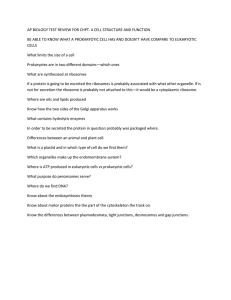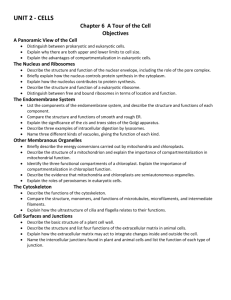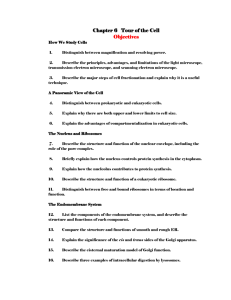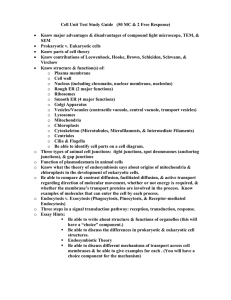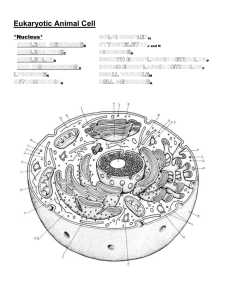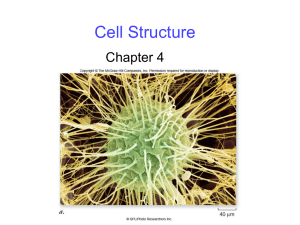Biology I: Cell Structure Study Guide - Chapter 4
advertisement
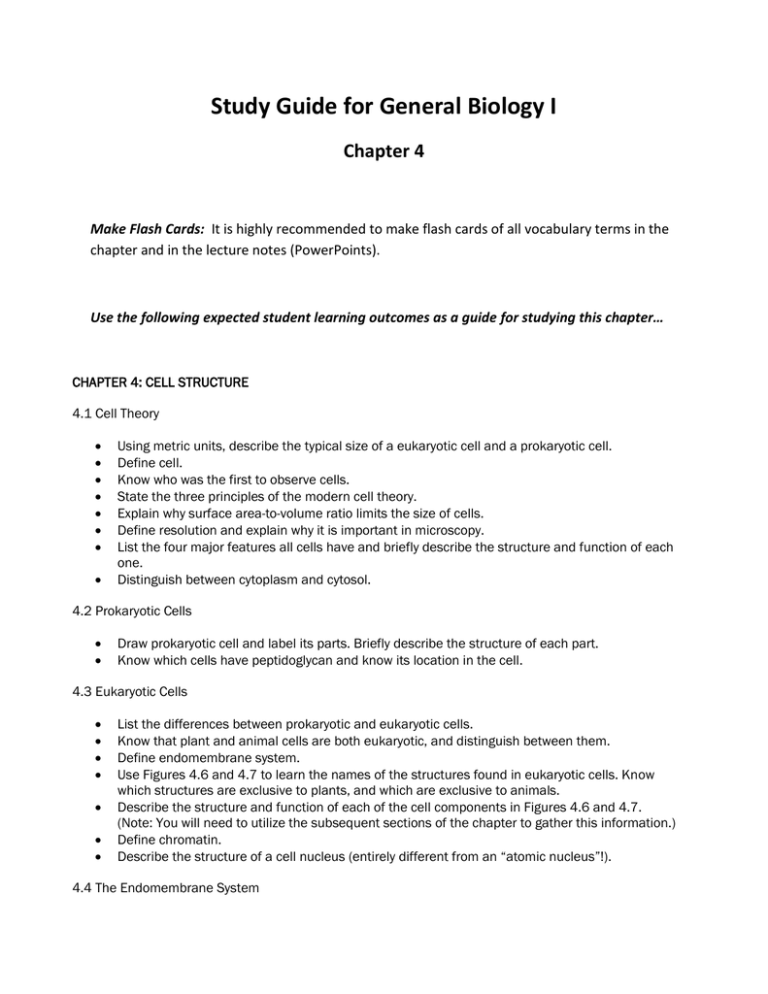
Study Guide for General Biology I Chapter 4 Make Flash Cards: It is highly recommended to make flash cards of all vocabulary terms in the chapter and in the lecture notes (PowerPoints). Use the following expected student learning outcomes as a guide for studying this chapter… CHAPTER 4: CELL STRUCTURE 4.1 Cell Theory Using metric units, describe the typical size of a eukaryotic cell and a prokaryotic cell. Define cell. Know who was the first to observe cells. State the three principles of the modern cell theory. Explain why surface area-to-volume ratio limits the size of cells. Define resolution and explain why it is important in microscopy. List the four major features all cells have and briefly describe the structure and function of each one. Distinguish between cytoplasm and cytosol. 4.2 Prokaryotic Cells Draw prokaryotic cell and label its parts. Briefly describe the structure of each part. Know which cells have peptidoglycan and know its location in the cell. 4.3 Eukaryotic Cells List the differences between prokaryotic and eukaryotic cells. Know that plant and animal cells are both eukaryotic, and distinguish between them. Define endomembrane system. Use Figures 4.6 and 4.7 to learn the names of the structures found in eukaryotic cells. Know which structures are exclusive to plants, and which are exclusive to animals. Describe the structure and function of each of the cell components in Figures 4.6 and 4.7. (Note: You will need to utilize the subsequent sections of the chapter to gather this information.) Define chromatin. Describe the structure of a cell nucleus (entirely different from an “atomic nucleus”!). 4.4 The Endomembrane System Identify the components of the endomembrane system and their function(s). Using words, trace the path of a phospholipid molecule from the endoplasmic reticulum to the plasma membrane. Using words, trace the path of a protein from the endoplasmic reticulum to the extracellular fluid. 4.5 Mitochondria and Chloroplasts: Cellular Generators List the structural similarities shared by mitochondria and chloroplasts. Explain how the meaning of the word mitochondria differs from the meaning of mitochondrion. Draw the structure of a mitochondrion and label its parts. Draw the structure of a chloroplast and label its parts. Describe how mitochondria and chloroplasts arose by endosymbiosis. 4.6 The Cytoskeleton Name the three types of cytoskeleton fibers. Know the function(s) of each type of cytoskeleton fiber. Know the types of proteins comprising each type of fiber. Know the relative sizes and general structure of each type of fiber. Define motor protein. Know the function of a motor protein. Define vesicle. Describe how vesicles can be moved around cells by way of motor proteins and microtubules, using ATP. 4.7 Extracellular Structures and Cell Movement Describe what happens when a cell “crawls”. Define basal body. Describe the structure of a eukaryotic flagellum and how it differs from a prokaryotic flagellum. Distinguish between cilia and flagella in terms of structure, number, and movement. Explain what is meant by the “9 + 2” structure. Know the function and chemical composition of plant cell walls. Know the chemical composition of fungal cell walls. Know that animal cells do not have cell walls. Define extracellular matrix. Know that integrin proteins extend through the plasma membrane, connecting the ECM to cytoskeleton fibers. 4.8 Cell-to-Cell Interactions Define glycolipid and describe the role of these molecules. Define MHC protein and define the role of these molecules. Distinguish among the structures and functions of adhesive junctions, tight junctions, and communicating junctions. Define desmosome, gap junction, and plasmodesmata. Explain how cell junctions can create sheets of cells. In addition to the above objectives, also do the following: Accomplish the “Learning Outcomes” in this chapter and be able to do the “Learning Outcomes Review” items. Read and look at the information in any “Scientific Thinking” figures for this chapter and be able to use the information to illustrate the classic steps and process of a scientific investigation. Know the material in the Chapter Review. Do the “Understand” and “Apply” questions in the chapter Review Questions and know why the correct answer is the right choice (and why the incorrect answers are the wrong choices). Be able to answer similar questions based on any of the above specific learning objectives.
